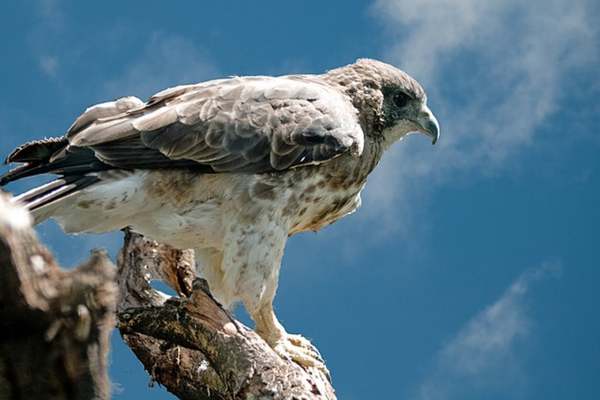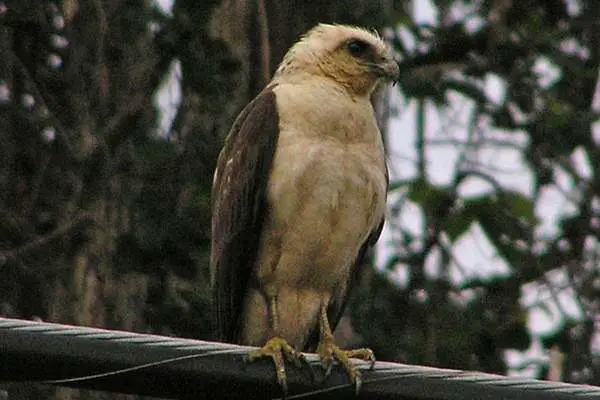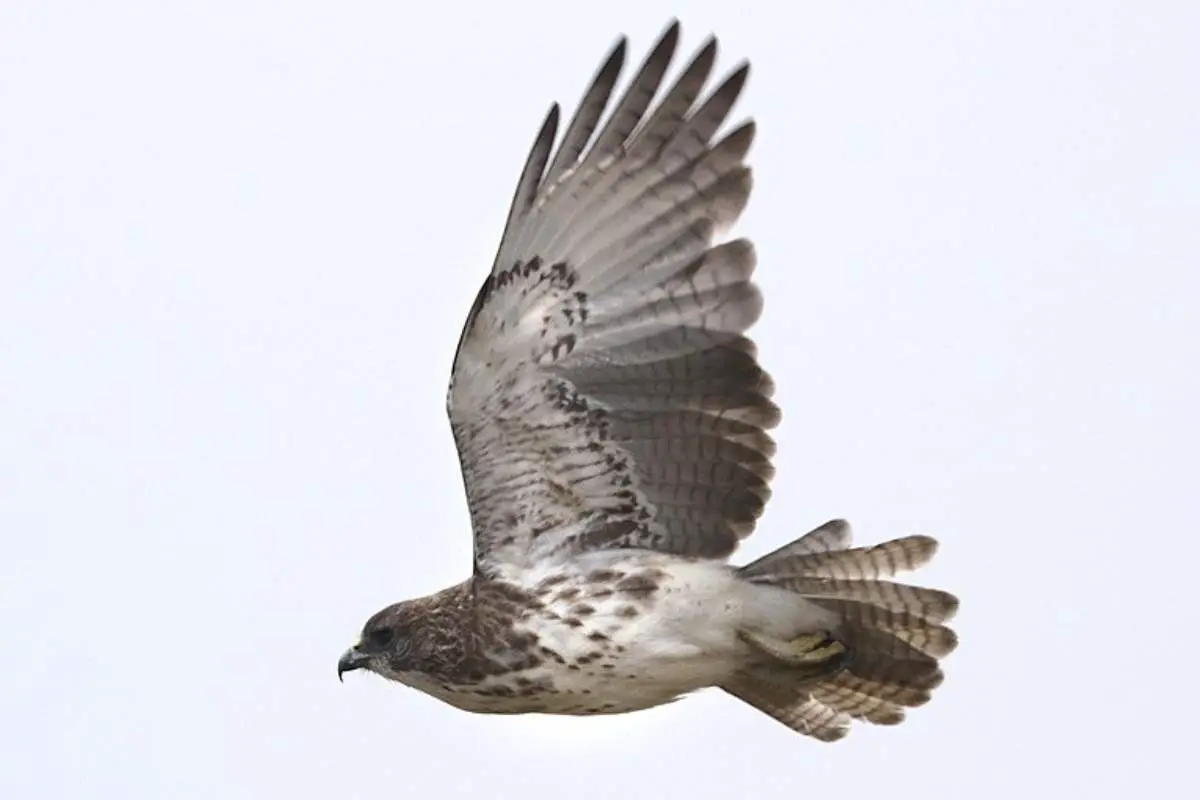Common Name: Hawaiian Hawk
Scientific Name: Buteo solitarius| Size | Diet | Range in Hawaii | Status in Hawaii |
|---|---|---|---|
| 18 in - 20 in. | insects, small mammals, birds, reptiles, and carrion | All Islands | Near Threatened |
The Hawaiian hawk (Buteo solitarius) is a medium-sized raptor that is native to the Hawaiian Islands. Also known as the io, it is found only in Hawaii and is non-migratory. It is a distinctive and iconic species in Hawaii and is an important cultural symbol for the Hawaiian people.
Hawaiian Hawk
APPEARANCE

The Hawaiian hawk is a medium-sized raptor with a distinctive appearance. It has a dark brown head and wings, with a white chest and belly.
The tail is also dark brown with a broad white band at the tip. The beak is black, and the legs and feet are yellow. Hawaiian hawks are typically about 18-20 inches in length and have a wingspan of about 40-45 inches.
They weigh about 1-2 pounds. The male and female Hawaiian hawks are similar in appearance, but the female is typically slightly larger. Both sexes have bright yellow eyes and sharp, curved talons.
DIET
The Hawaiian hawk is an omnivorous species, which means it feeds on a wide variety of plant and animal matter. Its diet includes a variety of insects, small mammals, birds, reptiles, and carrion. In addition to hunting for prey, the Hawaiian hawk will also scavenge for food and may feed on fruit and nectar. It is an opportunistic feeder and will take advantage of whatever food sources are available in its environment.
BEHAVIOR
Hawaiian hawks are solitary birds and are not typically found in flocks. They are territorial and will defend their territory against intruders. During the breeding season, the male and female will establish a territory and work together to defend it. Hawaiian hawks are known to be vocal birds and will make a variety of calls, including harsh screeches and whistles.
Hawaiian hawks are diurnal, which means they are active during the day. They spend their time hunting for food, resting, and preening their feathers.
They are skilled hunters and will use a variety of hunting techniques, including perching and waiting for prey, soaring and scanning for prey from the air, and diving or swooping down to capture prey. Hawaiian hawks are also skilled fliers and are able to navigate through the forest canopy and open spaces with ease.
NESTING
It builds its nests in trees, using sticks and twigs to construct a platform for the eggs. The female typically lays a clutch of one or two eggs, and both the male and female take turns incubating them for about 35 days. Once the eggs hatch, the parents feed and care for the chicks until they are ready to fledge, which typically occurs at about 5-6 weeks of age.
HABITAT

Hawaiian hawks are found in a variety of habitats, including forests, grasslands, and coastal areas. They are most common in areas with a mix of open spaces and forested areas, as this provides them with a diverse range of food sources and nesting sites. Hawaiian hawks are adapted to the tropical climate of Hawaii and are found at elevations ranging from sea level to over 6,000 feet.
RANGE
Hawaiian hawks are found throughout the Hawaiian Islands. They are native to all of the main islands, including Kauai, Oahu, Molokai, Lanai, Maui, and the Island of Hawaii. They are also found on a number of smaller islands, including Niihau, Kahoolawe, and Lanai. Hawaiian hawks are non-migratory and do not travel outside of the Hawaiian Islands.
CONSERVATION STATUS
The conservation status of the Hawaiian hawk is considered “Near Threatened” by the International Union for Conservation of Nature (IUCN). This means that the species is at risk of becoming threatened with extinction in the near future.
The main threat to the Hawaiian hawk is habitat loss due to development and other human activities. It is also at risk of predation by non-native species, such as cats and rats, which have been introduced to the islands.
INTERESTING FACTS
1. Hawk species that is native to Hawaii
The Hawaiian hawk is a species of hawk that is native to the Hawaiian Islands. It is the only hawk species that is found exclusively in Hawaii and is an important part of the islands’ ecosystem.
2. They are monogamous
Hawaiian hawks are known to form monogamous pairs, which means that they mate with a single partner for life. This type of pair bonding is common among birds of prey, as it helps to ensure that the pair has a stable breeding relationship and that both parents are able to share the responsibilities of raising their young.
Monogamy can help to increase the chances of reproductive success for the pair, as both parents are able to devote time and energy to caring for their offspring.
3. Culturally significant to the Native Hawaiian people
Hawaiian hawks are culturally significant to the Native Hawaiian people, who consider the hawks to be aumakua, or ancestral spirits that protect and guide them. Hawaiian hawks are considered to be sacred and are often depicted in traditional Hawaiian art and folklore. They are also important cultural symbols in Hawaii and are revered as symbols of strength, power, and good fortune.
4. Considered to be a keystone species
They are considered to be a keystone species, which means that they play a vital role in the ecosystem and the health of the ecosystem depends on their presence.
FREQUENTLY ASKED QUESTIONS:
How can I identify a Hawaiian hawk?
Hawaiian hawks can be identified by their distinctive appearance. They have a dark brown head, wings, and tail, and a lighter brown breast and belly. They have a white ring around the base of the bill and a small white patch on the neck. Hawaiian hawks also have bright yellow legs and feet.
How do they communicate?
They are known to communicate with each other through a variety of vocalizations, including calls, chirps, and clicks. They may also use body language and visual displays to communicate with one another, such as by puffing up their feathers or bobbing their heads. Like many birds, ‘io are also known to use scent to communicate, by releasing pheromones or marking their territory with urine.
How long do Hawaiian hawks live, on average?
In general, Hawaiian hawks are thought to have a lifespan of around 10-15 years in the wild. Some individuals may live longer, while others may die at a younger age due to predation, disease, or other causes.


